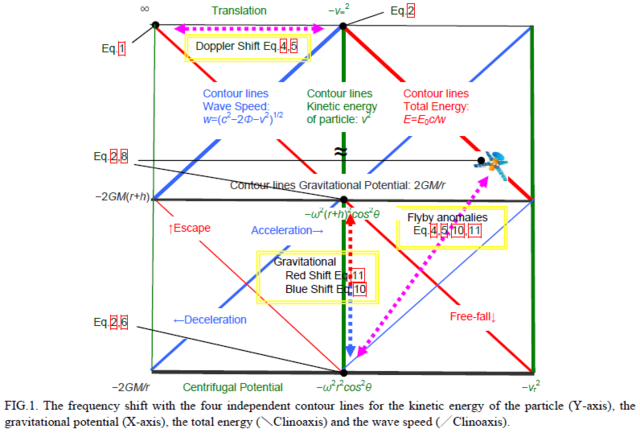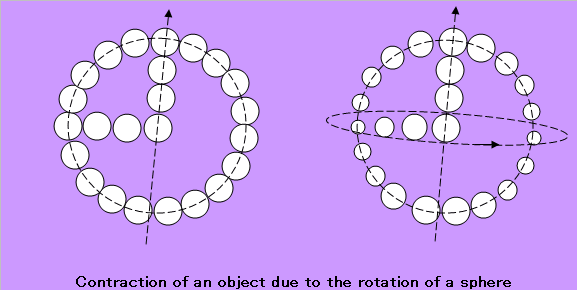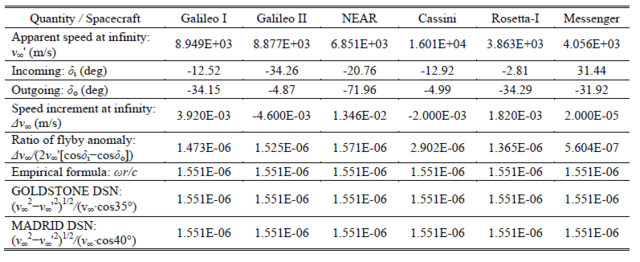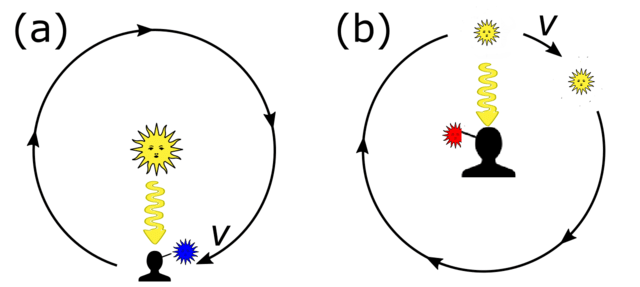Flyby anomaly by light of superluminal
Abstract
What is the Flyby Anomaly?
The flyby anomaly is a discrepancy between current scientific models and the actual increase in speed (i.e. increase in kinetic energy) observed during a planetary flyby (usually of Earth) by a spacecraft. In multiple cases, spacecraft have been observed to gain greater speed than scientists had predicted, but thus far no convincing explanation has been found. This anomaly has been observed as shifts in the S-band and X-band Doppler and ranging telemetry. The largest discrepancy noticed during a flyby has been 13 mm/s.[1]Possible explanationsThere have been a number of proposed explanations of the flyby anomaly, including:・It has been postulated that the Flyby Anomaly is a consequence of the assumption that the speed of light is isotropic in all frames, and invariant in the method used to measure the velocity of the space probes by means of the Doppler Effect.[14] The inconsistent anomalous values measured: positive, null or negative are simply explained relaxing this assumption. During flyby maneuvers the velocity components of the probe in the direction of the observer (Vo) are derived from the relative displacement (df) of the radiofrequency (f) transmitted by the probe, multiplied by the local speed of the light (c') by the Doppler effect: (Vo=[df/f]c'). According to the Céspedes-Curé hypothesis,[15], the movement through variable gravitational energy density fields produces slight variations of the refractive-index (n') of space, and therefore of the speed of light (c') which leads to unaccounted corrections of the Doppler data that are based on an invariant (c). This leads to incorrect estimates of the speed or energy change in the flyby maneuver on the Earth’s frame of reference.・Unaccounted transverse Doppler effect—i.e. the red-shift of light source with zero radial and non-zero tangential velocity.[13] However, this cannot explain the similar anomaly in the ranging data.
Explanation by the asymmetric Doppler effect of light


W₊=√(C²+[ω R cos θ]²) (1).
When this observer moves, the observed frequency (f) of the asymmetric Doppler effect of light is,
f=f₊/(1-V₊ cos α/W₊) (3).
α: Moving angle of the light source seen from the observer = Angle of the observer seen from the moving direction of the light source.

When the orbit of the spacecraft is applied to the hyperbolic trajectory in contact with it, and the asymptotic declination of approach and exit is (δi, δo), this equation (ΔV∞/V∞=K[cos δi-cos δo]) is expressed. However, the left side is the proportion of anomalies represented by hyperbolic excess velocity. The proportional coefficient K is (K ≈ 3.099 × 10-6), which is expressed as (K = 2ω R / c) using the Earth's rotation angular velocity ω and the equatorial radius R. However, c is the speed of light.
Conclusion
Mbelek stated that "this anomaly is apparent transverse Doppler effect in special relativity.". However, he casts it into a non-relativistic primary Doppler formula to explain the anomaly. This means that the observer's time is delayed according to the observer's movement, but the phenomenon cannot be explained only by the contraction of space-time in the direction of travel.
Lorenz, Absolute time + Object contracts in the direction of travel.
Einstein, Relative time + Time and space contracts in the direction of travel.
This paper, Relative time + Object contracts in the isotropically.
The observer's time is delayed, the observer contracts isotropically, the speed of light of other frames increases relative to the observer's frame, and the distance increases, resulting in a flyby anomaly in the Doppler effect and range data. Therefore, the formula for the asymmetric Doppler effect of light changes.

For mathematical consistency, Lorentz proposed a new time variable, the "local time", called that because it depended on the position of a moving body, following the relation t'=t-vx/c². [p13]. Lorentz considered local time not to be "real"; rather, it represented an ad hoc change of variable.
Like the flyby anomaly, it is difficult to obtain valid results for a moving observer, and has long relied on an approximation of the invariant speed of light. However, it can be said that the paradigm shift from the absolute stationary frame to the observational reference frame of speed of light is still halfway.
Acknowledgments


超光の光によるフライバイ異常
ReplyDelete宇宙理論でしめされている実験データを細かく調べ矛盾を実験されてる方がおられる。
自分の場合は、プールで泳ぐ際いろいろな気づきを得るが、このドップラー効果は、水の中で体験的に得られる。水と光もまた同性質があるのであろう。幾何学だけに限らないが3デメンションであるすべて、ほとんどすべての物質がその空間において、統一的なドップラー効果を得る。形が形をなすには、その法則は保たれているのだと思う。